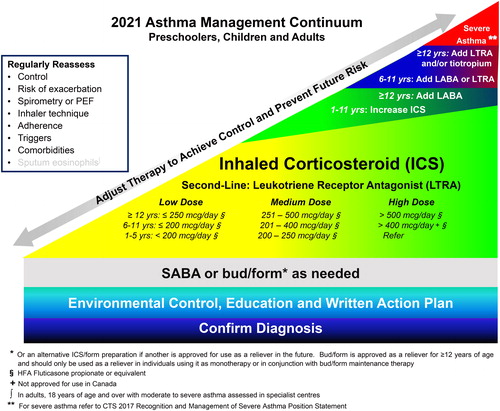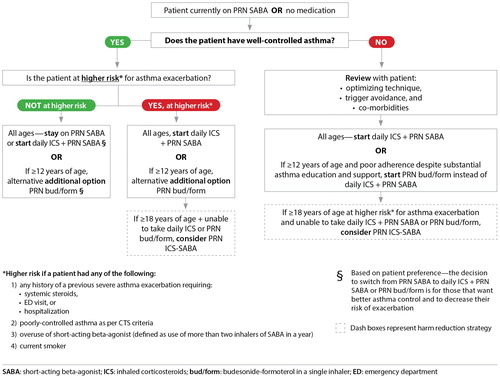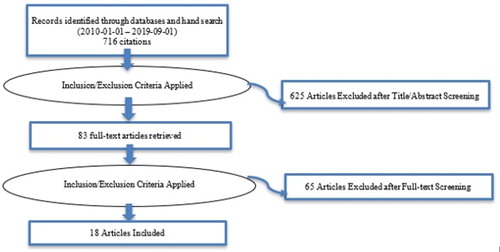Figures & data
Table 1. Severity classification.
Table 2. Comparative inhaled corticosteroids (ICS) dosing categories in preschoolers, children and adults.
Table 3. Well-controlled asthma criteria.
Figure 1. 2021 Asthma management continuum preschoolers, children and adults.
Management relies on an accurate diagnosis of asthma and regular reassessment of control and risk of exacerbation. All individuals with asthma should be provided with self-management education, including a written action plan. Adherence to treatment, inhaler technique, exposure to environmental triggers, and the presence of comorbidities should be reassessed at each visit and optimized.
Individuals with well controlled asthma on no medication or PRN SABA at lower risk of exacerbation can use PRN SABA, daily ICS + PRN SABA, and if ≥ 12 years of age PRN bud/form*.
Individuals at higher risk of exacerbation even if well-controlled on PRN SABA or no medication, and those with poorly-controlled asthma on PRN SABA or no medication should be started on daily ICS + PRN SABA. In individuals ≥ 12 years old with poor adherence despite substantial asthma education and support, PRN bud/form* can be considered. LTRA are second-line monotherapy for asthma. If asthma is not adequately controlled by daily low doses of ICS with good technique and adherence, additional therapy should be considered. In children 1-11 years old, ICS should be increased to medium dose and if still not controlled in children 6-11 years old, the addition of a LABA or LTRA should be considered. In individuals 12 years of age and over, a LABA in the same inhaler as an ICS is first line adjunct therapy. If still not controlled, the addition of a LTRA or tiotropium should be considered.
In children who are not well-controlled on medium dose ICS, a referral to an asthma specialist is recommended. After achieving asthma control, including no severe exacerbations, for at least 3-6 months, medication should be reduced to the minimum necessary dose to maintain asthma control and prevent future exacerbations.
HFA: hydrofluoroalkane; SABA: short-acting beta-agonist, LABA: long-acting beta-agonist, ICS: inhaled corticosteroid, LTRA: leukotriene receptor antagonist, bud/form: budesonide-formoterol in a single inhaler.

Table 4. Risk factors associated with severe asthma exacerbations
(This table is adapted from SIGN 158 - British guideline on the management of asthma by kind permission of the Scottish Intercollegiate Guidelines Network).Citation22
Table 5. Risk factors associated with near-fatal or fatal asthmaCitation10,Citation51
(This table is adapted from SIGN 158 - British guideline on the management of asthma by kind permission of the Scottish Intercollegiate Guidelines Network).Citation22
PICO 1. In individuals where the CTS currently recommend SABA PRN monotherapy (well-controlled as per CTS criteria) what are the best options for management?
PICO 2. In individuals where the CTS currently recommends ICS maintenance therapy + PRN SABA (not well-controlled on PRN SABA or well-controlled on daily low dose ICS + PRN SABA) what are the preferred treatment options for management?


